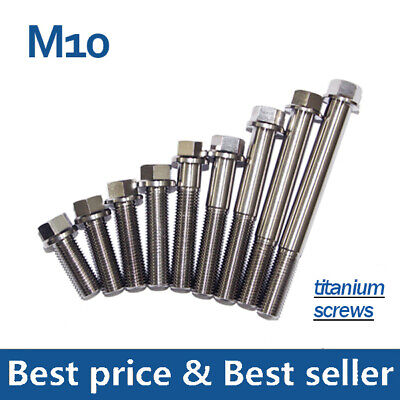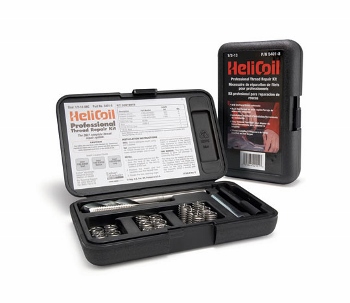I can't believe I'm disagreeing with
@Honcho , and others on something NSX related, but I'd like to propose a contrarian view. Trying a M10 bolt now
might have been reasonable with 7/16" fine thread (although I wouldn't try it myself with the hole expanded by more than 10%), but 7/16" coarse (1.81 mm) is quite far from 1.25 mm and a significant cross-thread:
First, I would not agree that threading in the OEM M10x1.25 bolt and attempting to torque to spec is a good idea. (Likely it won't hold the specified torque anyway, & might remove even more metal while cross-threading.) BUT, even if the M10x1.25 bolt appears to hold the torque spec, a significant portion of the back-torque from the bolt will be from cross-threading on the 7/16" coarse threads and not applied axial load on the bolt being applied as torque via the threads. The bolt will not be adequately tight axially. It might torque to spec, but that is NOT a guarantee of originally specified bolt pull-out strength, although lateral shear strength might be maintained.
But I'm also not convinced that this a good application for a HeliCoil. It's going to be tough to thread a HeliCoil, for several reasons. If the nutsert is loose, it will be difficult to drill the nutsert, even moreso to keep the hole on-axis, and difficult to verify. The HeliCoil tap will be similarly difficult to keep on-axis, as will the insertion of the HeliCoil itself. A top countersink will be impossible to assess. If the HeliCoil jams or breaks going in, you are scuppered.
But more importantly, a M10x1.25 HeliCoil will likely not be structurally sound in this hole because the hole has been expanded by the 7/16" bolt insertion. The nominal diameter of the 7/16" bolt (11.1 mm) is already significantly larger than the M10x1.25 HeliCoil drill-out diameter of 10.25 mm, so you won't have good material to tap the heli-coil threads into, before inserting the HeliCoil. At least 0.43 mm of the threads on each side of the nutsert will be garbage, twice tapped/cross-threaded metal, meaning the HeliCoil will be prone to jamming, may not thread in, and may not be structurally sound even if it does. HeliCoils have no strength; they hold by being wedged between the inner and outer threads. 11.1 mm is almost as large as the major diameter of the M10x1.25 HeliCoil tap (11.8 mm). I wouldn't do it without something specific from HeliCoil that it would fit their specs.
Helicoil tapping chart, helicoil tap chart , helicoil tap size, helicoil tap , helicoil taps, helicoil insert,helicoil inserts,helicoil tapping tool, helicoil tool, helicoil tools,helicoil tool kit ,helicoil thread gauge
www.noblefix.com
On the other hand, what's done is done. While you still have the problem of cross-threading back torque causing you to stop before the correct axial bolt load is reached, the very-hard Grade-8 7/16" bolt may have effectively "drilled out" and tapped the softer nutsert to a 7/16" coarse thread already. (
The coarse thread is stronger than M10x1.25, which is considered a fine thread.) I would remove the 7/16" coarse bolt, seeing how it comes out, and examine the threads. If it comes out axially without seeming to have been cross threaded, and its threads don't look damaged, I would see how that 7/16" bolt threads back in again after being cleaned up or, better yet, a new 7/16" coarse bolt since the 1st one might have been damaged using it as a tap. If it seems to thread in reasonably, without a lot of back torque, it could be reasonable to torque that bolt to the correct SM spec and call it done. That should be at least as strong as a M10x1.25 HeliCoil, as long as the nutsert is still on axis and not crooked. Likely a time where a "feel" by an experienced mechanic would be valuable. If the 7/16" bolt comes out wrecked and cross-threaded, I don't see another option besides replacing the nutsert and using a new M10 bolt-washer, the safest solution.
Is a lock washer, as the OP used, recommended? Is there one on the OEM bolt-washer? Hard to tell from the pics.
Careful documentation is needed going forward that the seat bolts are no longer uniform, and that 1 bolt and nutsert are now Imperial 7/16" coarse thread and should stay that way unless the bolt AND nutsert are replaced, so that someone doesn't just "correct" to the OEM bolt in future. (Thankfully, the bolt color is different, which should give someone a hint in future.) I've seen this done before intentionally when threads were stripped and helicoils could not be used. The next Metric thread was quite a jump in diameter, without enough surrounding metal, but there was an Imperial thread in the middle that could be tapped in (with a tap, not a larger bolt).
I do agree with the others that the car is probably fine to be driven, sans passenger, until this is fixed.













